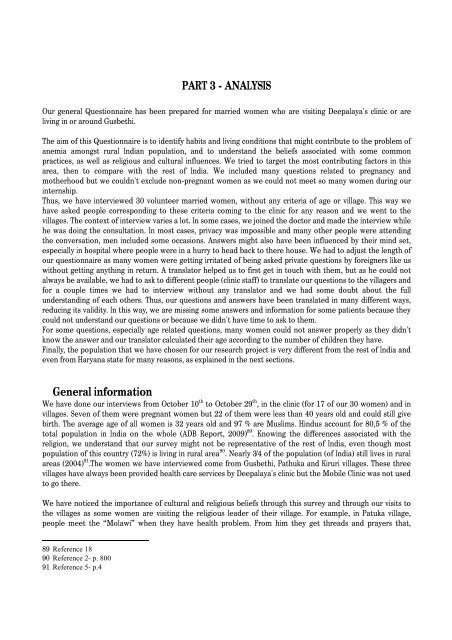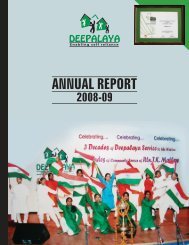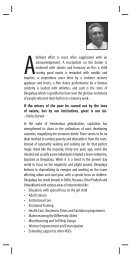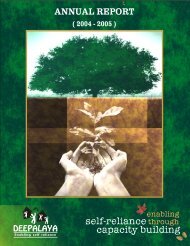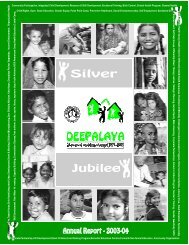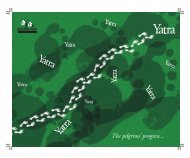Report 2011 - Deepalaya
Report 2011 - Deepalaya
Report 2011 - Deepalaya
Create successful ePaper yourself
Turn your PDF publications into a flip-book with our unique Google optimized e-Paper software.
PART 3 - ANALYSIS<br />
Our general Questionnaire has been prepared for married women who are visiting <strong>Deepalaya</strong>'s clinic or are<br />
living in or around Gusbethi.<br />
The aim of this Questionnaire is to identify habits and living conditions that might contribute to the problem of<br />
anemia amongst rural Indian population, and to understand the beliefs associated with some common<br />
practices, as well as religious and cultural influences. We tried to target the most contributing factors in this<br />
area, then to compare with the rest of India. We included many questions related to pregnancy and<br />
motherhood but we couldn't exclude non-pregnant women as we could not meet so many women during our<br />
internship.<br />
Thus, we have interviewed 30 volunteer married women, without any criteria of age or village. This way we<br />
have asked people corresponding to these criteria coming to the clinic for any reason and we went to the<br />
villages. The context of interview varies a lot. In some cases, we joined the doctor and made the interview while<br />
he was doing the consultation. In most cases, privacy was impossible and many other people were attending<br />
the conversation, men included some occasions. Answers might also have been influenced by their mind set,<br />
especially in hospital where people were in a hurry to head back to there house. We had to adjust the length of<br />
our questionnaire as many women were getting irritated of being asked private questions by foreigners like us<br />
without getting anything in return. A translator helped us to first get in touch with them, but as he could not<br />
always be available, we had to ask to different people (clinic staff) to translate our questions to the villagers and<br />
for a couple times we had to interview without any translator and we had some doubt about the full<br />
understanding of each others. Thus, our questions and answers have been translated in many different ways,<br />
reducing its validity. In this way, we are missing some answers and information for some patients because they<br />
could not understand our questions or because we didn't have time to ask to them.<br />
For some questions, especially age related questions, many women could not answer properly as they didn't<br />
know the answer and our translator calculated their age according to the number of children they have.<br />
Finally, the population that we have chosen for our research project is very different from the rest of India and<br />
even from Haryana state for many reasons, as explained in the next sections.<br />
General information<br />
We have done our interviews from October 10 th to October 29 th , in the clinic (for 17 of our 30 women) and in<br />
villages. Seven of them were pregnant women but 22 of them were less than 40 years old and could still give<br />
birth. The average age of all women is 32 years old and 97 % are Muslims. Hindus account for 80,5 % of the<br />
total population in India on the whole (ADB <strong>Report</strong>, 2009) 89 . Knowing the differences associated with the<br />
religion, we understand that our survey might not be representative of the rest of India, even though most<br />
population of this country (72%) is living in rural area 90 . Nearly 3/4 of the population (of India) still lives in rural<br />
areas (2004) 91 .The women we have interviewed come from Gusbethi, Pathuka and Kiruri villages. These three<br />
villages have always been provided health care services by <strong>Deepalaya</strong>'s clinic but the Mobile Clinic was not used<br />
to go there.<br />
We have noticed the importance of cultural and religious beliefs through this survey and through our visits to<br />
the villages as some women are visiting the religious leader of their village. For example, in Patuka village,<br />
people meet the “Molawi” when they have health problem. From him they get threads and prayers that,<br />
89 R e f e r e n c e 1 8<br />
90 R e f e r e n c e 2 - p . 8 0 0<br />
91 R e f e r e n c e 5 - p . 4


